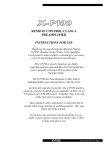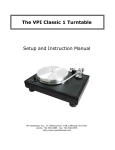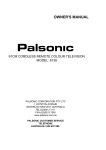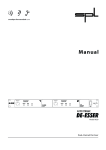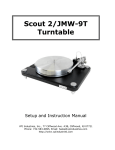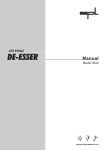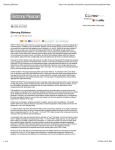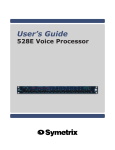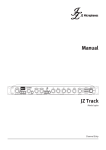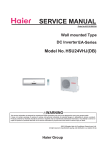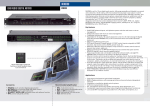Download Alesis M-EQ230 User's Manual
Transcript
Alesis M-EQ 230 DUAL 1/3 OCTAVE PRECISION EQUALIZATION SYSTEM USERS MANUAL A lesis M-EQ 230 DUAL 1/3 OCTAVE PRECISION EQUALIZATION SYSTEM INTRODUCTION The A lesis MEQ-230 is a two channel, 30 band/channel, 1/3rd octave graphic equalizer which features a relay based power-up delay switching circuit to eliminate turn-on transients in sound systems. Each channel features 30 bands of 1/3rd octave equalization with ANSI and ISO standard center frequencies. Each band is adjusted by a center detented fader with ±12dB of gain available, and a master fader controls system gain for that channel. Clip and signal present LEDs, as well as a bypass switch, are also provided on each channel. Inputs and outputs for each channel are via both 1/4" and RCA jacks. The unit can also be rack mounted in only 1 rack space. FEATURES • 2 complete 30 band 1/3 octave equalizers in 1 rack space • Power up delay circuitry protects speakers by eliminating turn-on transients • ±12dB boost or cut per band • Each channel can be bypassed individually • Clip and signal present LEDs for each channel • Inputs and outputs via both 1/4" phone and RCA jacks Applications • • • • • Feedback control in sound systems Feedback control in stage monitor systems Timbre contour of musical instruments Room voicing Special sound effects 2 SECTION 1 DESCRIPTION OF CONTROLS FRONT PANEL 1/3 OCTAVE BAND FADER Each 1/3rd octave band is controlled by a center detented fader which provides a boost or cut of 12dB. There are 30 bands per channel. MASTER CHANNEL GAIN FADER Each channel has a Master Gain Fader which controls the system's input gain by ±12dB. CHANNEL BYPASS SWITCH Each channel's EQ can be individually bypassed by means of the Channel Bypass Switch. The Master Gain Fader affects program input level only when the channel is not bypassed. EQ IN LED The EQ In LED lights when the EQ is in use. The LED will go out when a channel is bypassed. CLIP INDICATOR The red CLIP INDICATOR LED indicates the onset of distortion (+18 dB). This LED should never light during normal use. SIGNAL PRESENT LED The green SIGNAL PRESENT LED indicates that a signal is currently being fed into the M-EQ 230. This LED lights at approximately -20dB and should be frequently lit during normal use. POWER LED The POWER button turns the unit on or off. BACK PANEL INPUT JACKS (Left & Right) Accepts instrument to line level input signals for both left and right channels. Both 1/4" and RCA phono jacks are provided. OUTPUT JACKS (Left & Right) Line level output of the M-EQ 230 for both left and right channels. Both 1/4" and RCA phono jacks are provided. 3 POWER JACK Accepts the +9VAC power from the M-EQ 230 Power Supply. This external supply keeps hum, noise, and ground loops to a minimum. SECTION 2 SET-UP INSTRUMENTS, MICROPHONES The A lesis M-EQ 230 has high impedance inputs that are ideally suited for use either with instruments or line level signals. Although microphones can be connected directly into the M-EQ 230 , it is recommended that for quietest operation they be connected to a mixing console first and then connected to the MEQ 230 as described in Figure 1. STEREO OPERATION For stereo operation of the M-EQ 230, connect the left and right line outputs of the device to be equalized into the left and right inputs of the M-EQ 230. See Figure 1 FIGURE 1 M-EQ 230 STEREO OPERATION Alesis 1622 MIXING CONSOLE MAIN OUT LEFT MAIN OUT RIGHT LEFT INPUT RIGHT INPUT M-EQ LEFT OUTPUT LEFT INPUT 230 RIGHT OUTPUT RIGHT INPUT STEREO POWER AMP 4 INDEPENDENT USE OF LEFT AND RIGHT CHANNELS The M-EQ 230 need not be used in a stereo mode since each channel is completely independent. In Figure 2 , the right channel is connected to the house sound system for room tuning while the left channel is connected to the on-stage monitor system for feedback control. FIGURE 2 INDEPENDENT USE OF LEFT AND RIGHT CHANNELS Alesis 1622 MIXING CONSOLE AUX SEND OUT or MONITOR OUT MAIN OUT RIGHT OR LEFT LEFT INPUT RIGHT INPUT M-EQ 230 LEFT OUTPUT INPUT RIGHT OUTPUT INPUT MONITOR POWER AMP HOUSE POWER AMP 5 INTERFACING VIA INSERT SENDS AND RETURNS Another way of interfacing the M-EQ 230 is to connect the unit directly to the insert send and return patch points (if your console has them) of the channel that is to be effected. See Figure 3 FIGURE 3 INTERFACING TO A MIXING CONSOLE VIA CHANNEL INSERTS Alesis 1622 MIXING CONSOLE INSERT SEND RIGHT INPUT INSERT RETURN RIGHT OUTPUT M-EQ 230 6 SECTION 3 OPERATION POWER-UP When the power is first turned on, the automatic power-up delay circuit will mute the M-EQ 230 for 2 seconds. This is to prevent any possible turn-on transient signal from mixers, power amps, or outboard equipment from possibly damaging speakers. TO CONTROL FEEDBACK 1 ) Place all microphones in the positions where they will be used. Set mics to approximate levels. 2 ) Gradually bring up the sound system level until feedback just begins to occur. 3 ) Feedback will usually occur at two frequencies in each room; one low and one high. Determine which frequency is loudest (or that is feeding back first) by decreasing each slider until one is found that makes the feedback disappear (see Figure 4A). 4 ) After the feedback frequency is found, gradually increase the slider until just on the edge of feedback. 5 ) Now gradually decrease the two adjacent sliders until the feedback again disappears (see Figure 4B). 6 ) Gradually increase the sound system gain until feedback occurs again. 7 ) Repeat steps 3, 4, and 5. PLEASE NOTE: A) In many cases, room acoustics, uneven frequency response in speaker components and microphones, excessive gain due to poor microphone technique, poor placement of speaker systems, or many open microphones in the sound system will all contribute to feedback which can only be mildly controlled but not totally eliminated. If excessive EQ is being used it's best to try to correct some of the reasons for feedback first before resorting to EQ. 7 B) For feedback control, the sliders of the M-EQ 230 should always be operated in the downward or cut position. FIGURE 4 CONTROLLING FEEDBACK A. Find the 2 major feedback frequencies (1 high, 1 low frequency) B. Slightly decrease adjacent bands. A. B. ROOM FEEDBACK FREQUENCIES ADJACENT BANDS SLIGHTLY DECREASED FOR INSTRUMENT TONAL CONTOURING 1 ) Find the desired frequency band by either referring to the Frequency Chart (see Figure 5) or by experimenting. 2 ) Gradually raise the slider of the disired band and the two adjacent sliders gradually until the desired result is achieved. 3 ) Repeat as necessary. If you should find that you are adding large amounts of EQ boost with more than half of the sliders boosted, then the overall effect is 8 the same as simply raising the volume level. In this case, do the following: 1 ) With the instrument playing, start by boosting 3 sliders at a time until the offending frequency area is found. (If the Clip LED should light, turn down the Input control) 2 ) Now, decrease the sliders until you are cutting the level instead of boosting. 3 ) Experiment with the amount of decrease of the adjacent sliders as in feedback control (see Figure 4B). PLEASE NOTE: The M-EQ 230 (and all other graphic Equalizers) will sound best when the sliders show a gradual slope rather than a few wild boosts or cuts (See Figure 4A and 4B). Since the M-EQ 230 can be used with any electric instrument or microphone requiring tonal alteration, here are some generic suggestions as to setup. Since each instrument will sound different due to the uniqueness of the instrument itself, the type of music being played, the arrangement, and the touch of the player, you must use your ears (and the chart below) to ultimately find the correct settings. FIGURE 5 KEY FREQUENCIES FOR INSTRUMENTS INSTRUMENT KEY FREQUENCIES Bass Guitar Attack or pluck is increased at 700 or 1KHz; Bottom added at 60 or 80Hz; string noise at 2.5KHz Bass Drum Slap at 2.5KHz; Bottom at 60 or 80Hz Snare Fatness at 240Hz; Crispness at 1 to 2.5KHz; Bottom at 60 or 80Hz Hi-Hat and Cymbals Shimmer at 7.5 to 10KHz; Klang or gong sound at about 200Hz Toms Attack at 5KHz; Fullness at 240Hz Floor toms Attack at 5KHz; Fullness at 80 or 120Hz Electric Guitar Body at 240Hz; Clarity at 2.5KHz Acoustic Guitar Body at 240Hz; Carity at 2.5KHz; Bottom at 80 or 120Hz Piano Bass at 80 or 120Hz; Presence at 2.5 to 5KHz; Crispness at 10KHz; Honky-tonk sound at 2.5KHz as bandwidth is narrowed; Resonance at 40 to 60Hz Horns Fullness at 120 or 240Hz; Shrill at 7.5 or 5KHz 9 Voice Fullness at 120Hz; Boominess at 200 to 240Hz; Presence at 5KHz; Sibilance at 7.5KHz; Air at 12 to 15KHz Harmonica Fat at 240Hz, bite at 3-5kHz Conga Resonant ring at 200 to 240Hz; Presence and slap at 5KHz Whether used to alter the timbre of an instrument, control feedback, or improve speech intelligibility, it's important to know what effect each portion of the frequency spectrum has on the sound. In summary, the frequency spectrum can be divided up into six important sections. FIGURE 6 AUDIO OCTAVE RANGES FREQUENCY RANGE 16Hz to 60Hz 60Hz to 250Hz 250Hz to 2000Hz WHEN USED PRODUCES THIS EFFECT sense of power, felt more than heard Fundamentals of rhythm section, EQing can change musical balance making it fat or thin Low order harmonics of most musical instruments 2KHz to 4KHz Speech Recognition 4KHz to 6KHz Clarity and definition of voices and instruments, makes music seem closer to listener, adding 6dB at 5KHz makes entire mix seem 3dB louder Brilliance and clarity of sounds 6KHz to 16KHz WHEN USED TOO MUCH PRODUCES THIS EFFECT makes music muddy makes music boomy telephone quality to music 500 to 1KHz horn-like, 1K to 2KHz tinny, listening fatigue 3KHz listening fatigue, lisping quality, "m", "v", "b" indistiguishable sibilance on vocals sibilance, harshness on vocals As with any signal processor, the M-EQ 230 should be used with discretion since too much of a good thing can make the sound worse instead of better. Although it is a wonderful device and will help your sound a lot, remember that a little goes a long way. If you're using the M-EQ 230 for tonal contour of an instrument or voice, Figure 5 will help you zero in on the key frequencies of some popular instruments. Remember: The chart serves only as a starting point. you must use your ears as a guide. 10 Ultimately, SECTION 4 SPECIFICATIONS ELECTRICAL CHARACTERISTICS FREQUENCY RESPONSE 25Hz to 20kHz in 1/3 octave increments HARMONIC DISTORTION .004% @ 1KHz @ 0dBV NUMBER OF CHANNELS NOMINAL LEVEL MAXIMUM LEVEL IMPEDANCE 2 0dBV +18dBV 1MΩ OUTPUT NUMBER OF CHANNELS MAXIMUM LEVEL IMPEDANCE 2 +18dBV 240Ω INPUT FRONT PANEL CONTROLS INDICATORS SWITCHES REAR PANEL JACKS POWER 30 Band, 1/3rd octave , ±12dB, center frequencies set to ANSI and ISO standards. Power, Signal Present, Clip and In/Out LEDs per channel In/Out Input Left and Right - 1/4" and RCA Output Left and Right - 1/4" and RCA Power - Barrel Jack REQUIREMENTS 9 Volts AC, 7.5 Volt Amps external transformer, UL approved. DIMENSIONS (W x H x D) 19" x 1.75" x 4" WEIGHT 2.5 lbs.











